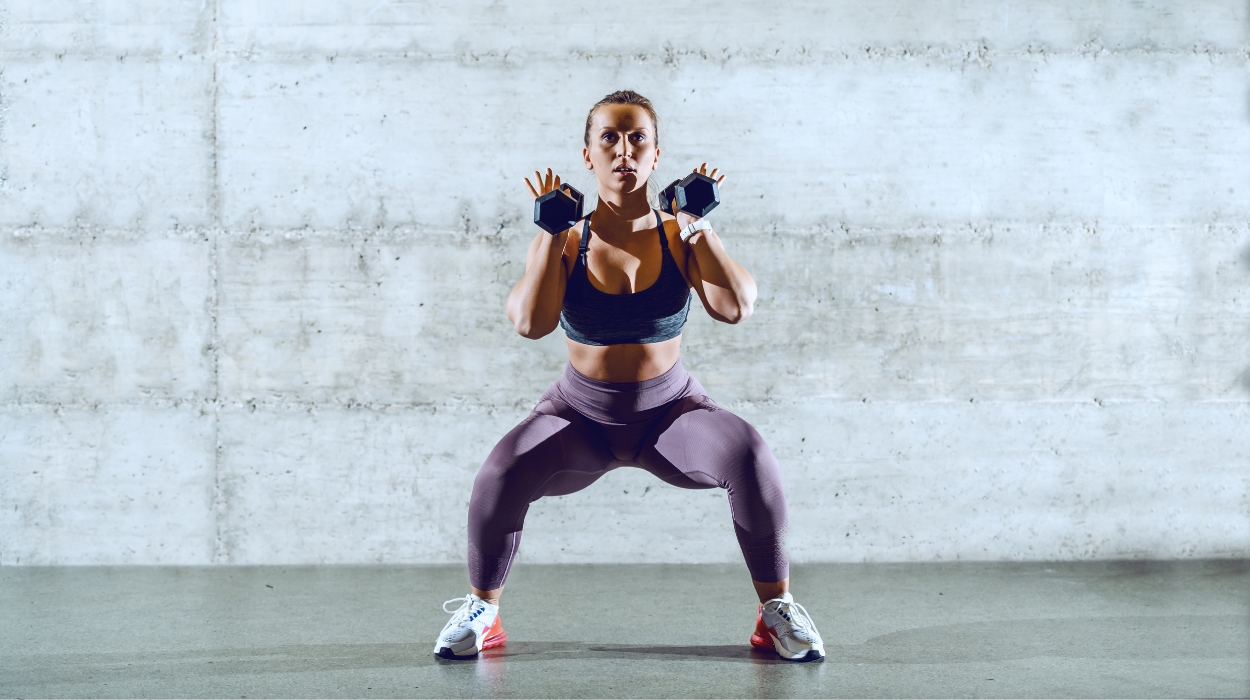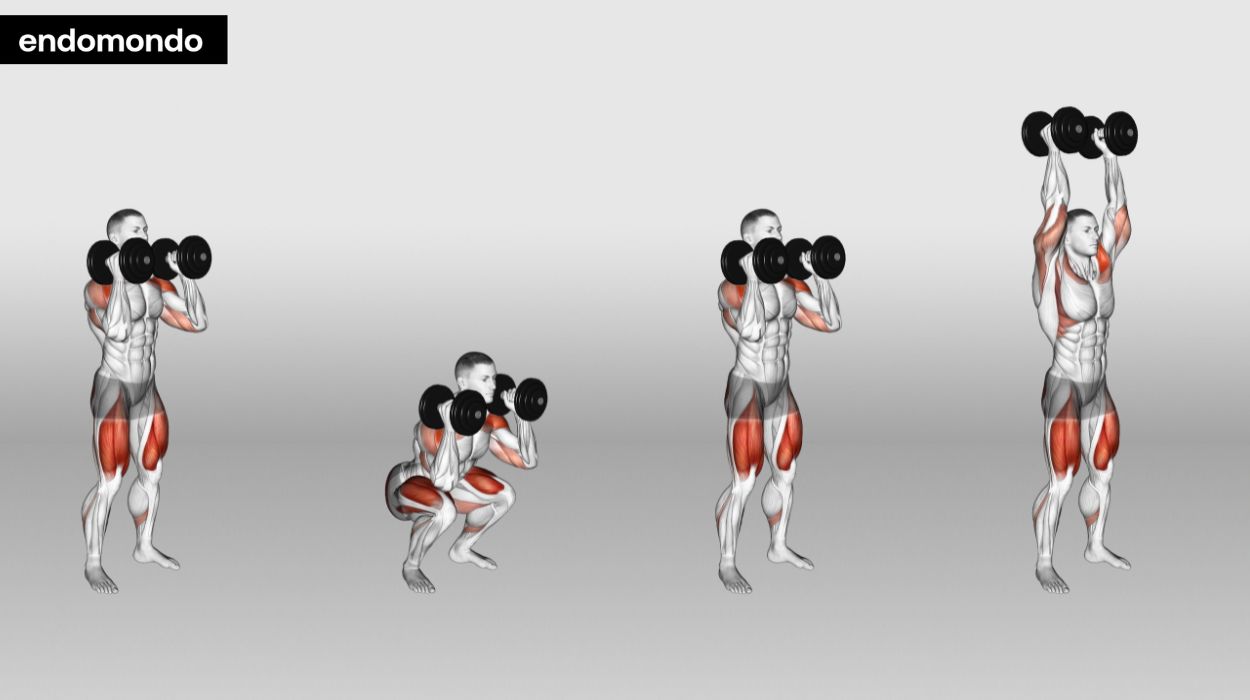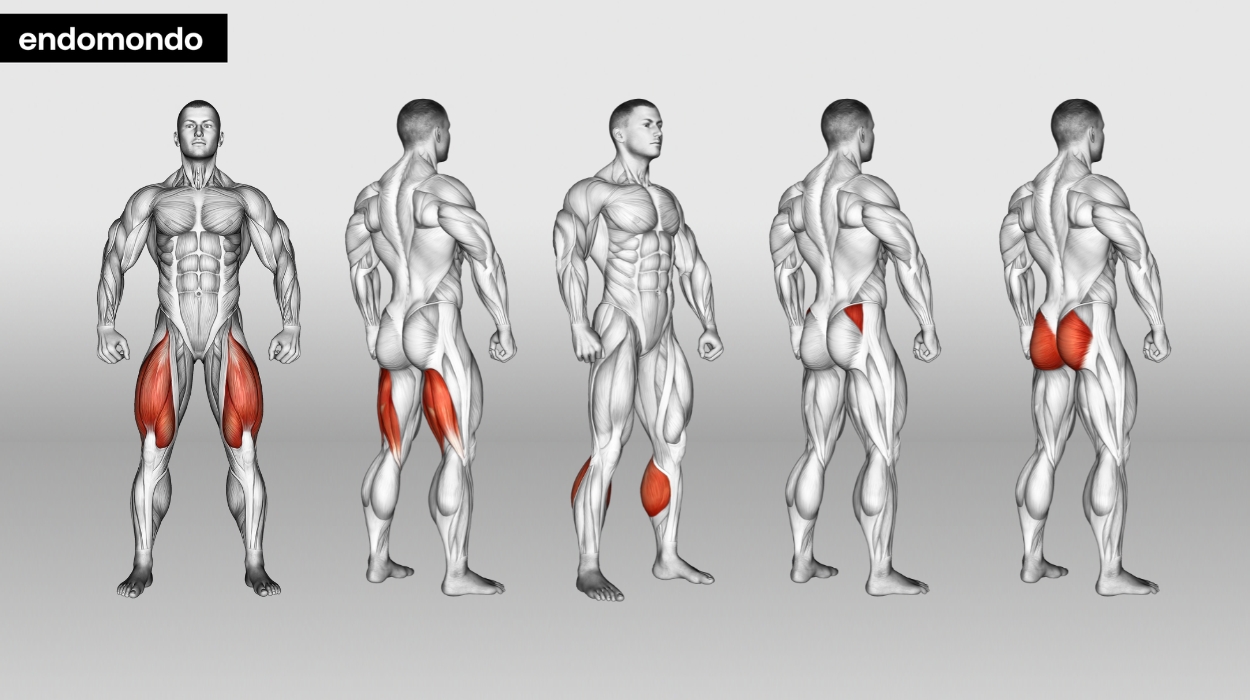
The squat and overhead press are both classed as compound movements, meaning they work for several major muscle groups. Resistance training is well known for its range of mental[1] and physical benefits[2] when performed regularly.
Combining the two exercises into a dumbbell-squat movement gives you a full-body workout. It also combines the benefits of both movements. The dumbbell squat to overhead press is the perfect option if you enjoy performing functional movements.
We’ve described the correct squat to overhead press exercise form in detail below. Our detailed guide looks at the technique cues, muscles worked, and benefits of performance.
After reading this article, you’ll have everything you need to get bigger shoulders. Also, make sure to read our guide on what to eat before a workout once you’ve finished this one.
How To Do Squat To Overhead Press?
The squat to overhead press form can be split into three main phases. Follow the steps below:
- Set up Phase – Hold a dumbbell in each hand at shoulder height. Stand with your feet shoulder-width apart. Brace your core. Keep your chest up and head facing forward.
- Squat to Press Phase – Perform a hip hinge to lower into a squat. Squat down until your thighs are parallel to the floor. Drive your hips forward back up to the starting position, pressing the weights overhead as your knees extend.
- Descend Phase – Bring the dumbbells back to shoulder height under control and repeat.
How To Do Squat To Overhead Press

Combining the squat and overhead press takes practice to perform correctly. Ditch the shoulder workout machine and have a go at some dumbbell squat thrusters.
The technique cues described below should be followed to ensure safe exercise performance.
Set Up Phase
- Assume a shoulder-width stance. Lift the dumbbells to shoulder height at the front of your body. Your elbows should be tucked in and in front of you. Your palms should be facing inward toward each other. This is the correct starting position.
- Keep your feet shoulder-width apart. Ensure your ribs are stacked in line with your pelvis. Keep your head in a neutral position. Take a deep breath in.
Squat To Press Phase
- Using your breath, engage your core and hinge your hips back taking a deep breath in through your nose. Bend your knees until your thighs are parallel to the floor. Keep your spine straight and keep the weight at shoulder height.
- Once your lower body is parallel, drive your legs and stand up. Keep your elbows tucked in.
- Once your knees and hips are fully extended, press the dumbbells overhead. Use your shoulders and legs to fully extend your elbows. Keep your feet firmly against the floor. Breathe out through this entire push motion.
- As you press the dumbbells overhead, rotate your palms forward.
Descend Phase
- Bring the dumbbells back to the starting position under control. Rotate your palms so they are facing each other.
- Once the dumbbells are at shoulder height, exhale and get ready to perform another repetition.
Squat To Overhead Press Benefits
The benefits of performing dumbbell squat thrusters are wide-ranging. Different exercise variations may be performed as part of a shoulder and bicep workout or with other muscle groups.
We’ve listed the main ones below.
Full-Body Workout

Dumbbell squat thrusters combine the shoulder press and squat into one movement. They require several major muscle groups to work together to perform them correctly.
The squat portion primarily involves your lower body muscles. These include your quads, hamstrings, calves, glutes, and core. The pressing portion involves your shoulders, trapezius, and tricep muscles.
Develop Strength And Power
During the dumbbell squat, you use your lower body to help generate pressing force to bring the dumbbells overhead. This helps you learn how to generate strength and power from the ground up.
The dumbbell squat uses an explosive movement pattern which helps generate a large amount of power in a short amount of time. This can then translate into improved sports performance.[3]
Also, make sure to read our guide on what to eat before a workout before performing dumbbell squat thrusters. Good nutrition[4] is also needed to build strength and power.
Uses Functional Movement Patterns
When performed correctly, dumbbell squat thrusters use three functional movement patterns.[5] These are the hip hinge, overhead press, and squat. They require several large muscle groups and stabilizer muscles to work together to maintain stability and balance.
Many daily tasks employ the same movement patterns. These include reaching overhead to a cupboard or picking something heavy up off the floor. Developing strength and power in these movements translates well into daily tasks.
Squat To Overhead Press Variations
Squatting while pressing a pair of dumbbells overhead can be done in several ways. The two variations below offer different workout challenges.
They can be performed as part of a shoulder workout at home or in the gym.
Push Press
The push press uses a simplified movement pattern. Instead of fully squatting down, you perform a slight knee bend as you press the weights overhead.
Both exercises use the same large muscle groups and help to generate strength and power from the floor.
- Lift each dumbbell to shoulder height. Keep your feet hip-width apart.
- Perform a slight knee bend and engage your core. Breathe in as you lower down.
- As you exhale, press both dumbbells overhead until your elbows are fully extended. Drive your legs at the same time by extending your hips and knees.
- Return to the starting position, bringing the dumbbell back down to your upper chest.
Single-Arm Squat To Overhead Press
The single-arm squat to overhead press uses one dumbbell at a time. This gym exercise challenges your core strength and stability more than the traditional squat thruster.
- Place a dumbbell next to one foot and lift it to shoulder height. Make sure your elbow is tucked in and facing in front of your body. Keep your feet hip-width apart.
- Inhale and engage your core. Hinge at your hips and lower into a squat. Continue lowering until your thighs are parallel to the floor.
- Extend your hips and knees whilst simultaneously pressing the dumbbell overhead. Once your arm is fully extended, return to the starting position.
Conclusion
The overhead squat press is a challenging full-body exercise. It helps to develop strength and power using functional movement patterns that translate well into daily life. The benefits of squats and overhead presses are combined into one movement.
Use the correct form above to perform dumbbell squat thrusters correctly. The variations mentioned above can be added to your shoulder workouts if desired.
Frequently Asked Questions
The squat to overhead press combines two popular movements into one. It’s a great full-body exercise to build strength, conditioning, and mobility. It has several possible exercise variations which can be performed depending on your ability level.
The squat to overhead press is a compound exercise which means it works several major muscle groups. The squat portion targets your quadriceps, hamstrings, glutes, calves, and core. The shoulder press portion targets your shoulders, trapezius, pectoralis major, and triceps.
Engage your core and hinge at your hips. Bend your knees until your thighs are parallel to the ground. Drive your legs and stand back up. Press the dumbbells and rotate your palms until your arms are fully extended.
Resources
- SantaBarbara, N.J., Whitworth, J.W. and Ciccolo, J.T. (2017). A Systematic Review of the Effects of Resistance Training on Body Image. The Journal of Strength and Conditioning Research, [online] 31(10), pp.2880–2888. doi:https://doi.org/10.1519/jsc.0000000000002135.
- Hughes, D.C., Ellefsen, S. and Baar, K. (2017). Adaptations to Endurance and Strength Training. Cold Spring Harbor Perspectives in Medicine, [online] 8(6), pp.a029769–a029769. doi:https://doi.org/10.1101/cshperspect.a029769.
- Morris, S.J., Oliver, J.L., Pedley, J.S., G. Gregory Haff and Lloyd, R.S. (2022). Comparison of Weightlifting, Traditional Resistance Training and Plyometrics on Strength, Power and Speed: A Systematic Review with Meta-Analysis. Sports Medicine, [online] 52(7), pp.1533–1554. doi:https://doi.org/10.1007/s40279-021-01627-2.
- Damas, F., Libardi, C.A. and Ugrinowitsch, C. (2017). The development of skeletal muscle hypertrophy through resistance training: the role of muscle damage and muscle protein synthesis. European Journal of Applied Physiology, [online] 118(3), pp.485–500. doi:https://doi.org/10.1007/s00421-017-3792-9.
- Myer, G.D., Kushner, A.M., Brent, J.L., Schoenfeld, B.J., Hugentobler, J., Lloyd, R.S., Vermeil, A., Chu, D.A., Harbin, J. and McGill, S.M. (2014). The Back Squat. Strength and Conditioning Journal, [online] 36(6), pp.4–27. doi:https://doi.org/10.1519/ssc.0000000000000103.




